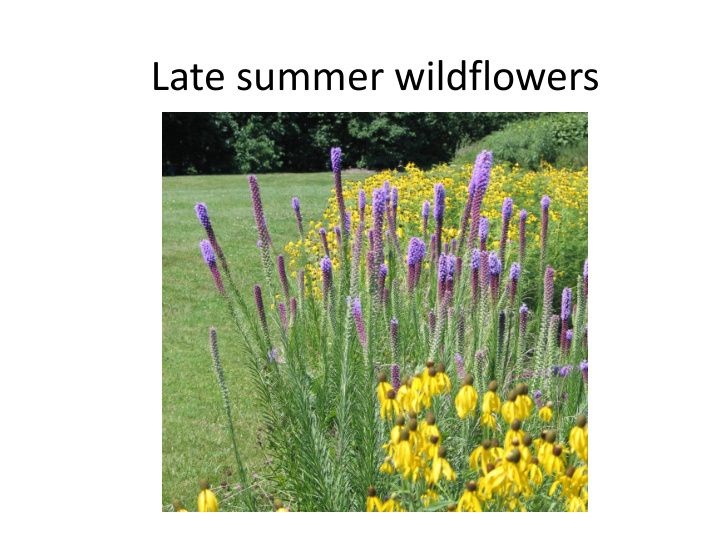



Late summer wildflowers
Fall-Winter
Wildflowers, grasses, tiny lawn!
Naturalized area
DEEP natural border (the way borders are supposed to be!)
Hudson River Valley has some of the most beautiful natural places
Flowers in my butterfly-bee-bird garden, first year
Some reasons to plant native gardens • 1. Maintenance – save time and $$$ • 2. Conserve water • 3. Prevent water and air pollution • 4. Control pests without chemicals • 5. Save pollinators from pesticides • 6. Save water animals from pesticides and fertilizers. • 7. Reduce noise pollution • 8. Attract wildlife and give it food, shelter, nesting habitat • 9. Reduce habitat loss • 10. Refuel your innate connection with Nature • 11. Other?
Monarch on Milkweed (Asclepias), where it lays its eggs
Swallowtail butterfly (mature)
Native tree - Sassafras leaves (mittens)
Spicebush drupes
Spicebush flowers
Spicebush (Lindera benzoin)
Spicebush (mature)
Swallowtail butterfly larvae (feeds only on Spicebush and Sassafras)
A standoff: who’s scaring whom?
‘Wild’life that can live in the garden
Some excellent native plants • (SHRUBS) • Spicebush • Clethra alnifolia • Solidago (goldenrod) • Asclepias (for monarchs) • Joe Pye Weed • Aralia spinosa (attracts bluebirds) • Winterberry • Late bottlebrush buckeye • Oakleaf hydrangea • (continued)
Some excellent native plants (cont.) • (TREES) • Prunus Serotina (native black cherry) • Sweetbay magnolia • Green hawthorn • Amelanchier • White fringetree • Franklinia • Smoketree • OAKS! • (VINES) Lonicera, Campsis radicans (hummingbirds)
(Native) Oakleaf hydrangea – species form
Muhly grass
Equisetum ‘living wall’
Bottlebrush buckeye flowers
Native: Cercis canadensis (redbud)
Landscape Principles • 1. Right plant, right place • 2. Intentional, unified; not piecemeal. Some repetition of plants • 3. Variety of shape, sizes, textures, leaf and flower colors • 4. Massing • 5. Layering • 6. 4-season interest: blooms, bark, berries, architecture • 7. Sequential interest/color. Something standing out at any particular time.
“Natural,” but sedums aren’t native
NAG at National Arboretum
NAG: Non-natives looking native
NAG: layering and massing
NAG: mid-summer Aster, Joe Pye weed, Sedum, River birch
NAG: Limestone fountain on uncrowded hillside, early spring
NAG: Massing made simple
NAG: Molinaria, Liriope, Hypericum calycinum (St. John’s Wort), Russian sage, Astilbe, Pennisetum (Oriental fountain grass)
NAG: bordered walkway, late summer: Artemisia ‘Silver Mound,’ Hibiscus moscheutos, Yucca pendula, upright Calamagrostis and larger Miscanthus grasses
NAG: blurred edges, backlighting, Liatris, various grasses, & juniper
Favorite perennials of the New American Garden • Aralia racemosa • Coreopsis verticillata • Joe Pye Weed • Hibiscus moscheutos • Liatris • Lythrum (not invasive here) • Black-eyed Susan • Yucca filimentosa • Deschampsia (tufted hair grass) • Panicum and Miscanthus grasses • Amelanchier (large shrub or small tree) • Hypericum calycinum
Favorite Perennials of the New American Garden (continued) • Artemisia ‘ Silver Mound’ • Aster x frikartii • Astilbe taquetii • Caryopteris x clandonensis • Daylily ‘Stella d’Oro’ • Hosta • Hypericum (St. John’s Wort – several sizes) • Ligularia • Lambs ears
Containers can have impact
A deck corner has its own ‘wildness’ with containers & hummer feeder (unseen)
Exquisite annual hydrangea
A simple patio made colorful with just a few annuals in containers
Old front stoop gets a facelift
Maple shaped leaves and nodding orange, old-fashioned flowers: a prairie look?
A few additional favorites of mine • Nandina domestica species form • Mahonia bealii • Perennial plumbago • Perennial begonia • TREES (not exhaustive) Franklinia, Hawthorne ‘ Winter King,’ River Birch, Sweetbay magnolia • Hakone grass • ‘ Nellie Stevens’ holly
Achillea (looks native to me!)
Fall Japanese Maple colors (not native but can’t live without them)
Begonia grandis, Hakone grass, Japanese painted fern in SHADE
Begonia grandis / liriope vignette
Perennial plumbago – fabulous groundcover w/red fall color too
Peonies (not native, but can’t live without them!)
Lily-of-the-valley The heavenly fragrance goes with me to the bridge table
Oh--and the lilacs go to the table with me, too
CRAPEMYRTLE ‘Chickasaw’ only grows to 1-3 feet high!
“Natural” or “native”
Wildflowers – prairie effect
More natural walkway Front of house!
Natural woodland floor – but designed
If they spread into the lawn area their orderly garden would look even more natural
BE CREATIVE! Boulder art
My dream: wildlife and whimsy in the same garden. Put YOUR wild ideas in YOUR garden
National Wildlife Foundation’s “Certified Wildlife Habitat” Garden • Contains: • - sustainable habitat • - water source(s) • - nesting boxes • - FOOD of various kinds, for various creatures • - cover for wildlife to escape view • - places to raise young • - sustainable, natural planting & maintenancepractices
Recommend
More recommend